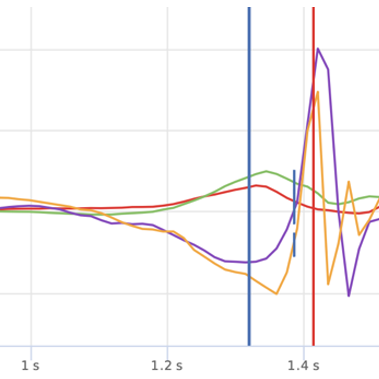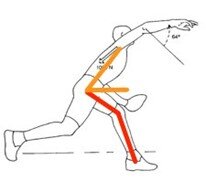
It’s no mystery that one of the keys to successful pitching is a consistent release point. While I do believe that the term “repeatable delivery” is a bit of a stretch, and that many times inconsistency in your arm slot can be a major cause of difficulty in repeating your delivery, I believe we need to dig a little deeper and look closer down the kinetic chain to lower half pitching issues.
I see a lot of young pitchers that are trying to tweak their arm slot mechanics and others that may have discomfort in their shoulder or elbow and are trying to take some pressure off affected area by changing their slot as well. However, the act of throwing a baseball is a sequence of kinetic chain events starting from the core (proximal) down to the lower half and back up through the chain ultimately leading to your release point. It’s hardly ever a single issue, but there are several factors associated with your lower half and core that may be leading to an inconsistent release point.

A biomechanical study conducted by ASMI looked at biomechanics during a game to observe if arm slot and release points change during the course of the game (“Pitching biomechanics as a pitcher approaches muscular fatigue during a simulated baseball game“). They discovered that as the game went on and the pitcher became tired, there was really no change in his arm slot. As a matter of fact, there were little biomechanical changes. However, they did notice two things:
-
- Decrease in lead knee flexion
- Decrease in trunk flexion
This shows that as a baseball pitchers body gets tired over the course of a game, their ability to stabilize the lower half gets compromised as well as the cores ability to hang on, causing the trunk to be more become more upright at release. This can contribute to a higher and inconsistent release point without having much to do with the pitcher’s arm slot. This is an important factor in understanding why a pitcher leaves his pitches up and has trouble getting the ball down in the zone late in the game.

While there are many issues that can be causing inconsistency at release, if you have mobility or stability concerns in your lower half and core, your body is going to make adjustments all the way up the kinetic chain ending with your arm in order to throw strikes more consistently. These compensations are going to lead to not only decreased performance but wear and tear on the shoulder and elbow as well.
The body has its own agenda, so while you can make adjustments to your arm action early on, without cleaning up mobility or stability concerns down below is going to make it hard for any type of changes to stick. There are many pitching issues that one can trace back to the body and the weight room. That being said, let’s review 5 lower half issues that I feel may be preventing a consistent release point:
-
- Lead Leg Quad and Hip Strength and Endurance
- Pelvic Tilt and Anterior Core Strength and Endurance
- Restricted Lead Hip Mobility and Adductor Strength
- Restricted Rear Hip Mobility
- Poor Rear Leg Stability
1. Lead Leg Quad and Hip Strength and Endurance
A strong and stable lead leg will help the athlete better decelerate linear forces and transfer force up and into the torso and arm. But in keeping with today’s topic of consistent release points, this same stability will many times allow a pitcher to remain on the ball longer. This can go a long way in adding to perceived velocity as well as more leverage on the ball and higher spin rates. Along with this strength/stability a pitcher also needs to train muscular/power endurance in order to maintain a more stable and consistent release point as the game goes into later innings.
Training Strength – Strength is the foundation that all other types of strength and power are built on.
(Reverse Lunge)
Power / Endurance – While, using lighter loads to enable more dynamic/explosive movement and working in work/rest ratios similar to that of the sport, helps athletes maintain that power from inning -to-inning.
(Split Squat Jumps)
2. Pelvic Tilt and Anterior Core Strength and Endurance
In our Mocap studies, forward trunk flexion angle at release has been shown to be one of the top three positions that correlate the highest to throwing velocity. It can also do wonders for creating a more consistent trunk flexion angle at the point of release. Two of the key players here involves working on co-contraction of the hip and anterior core strength.
Here is an example of a great drill that works on both. Co-contracting the glute and the quad simultaneously helps set and stabilize the pelvis while emphasizing a reach at the top trains both the anterior and oblique chain.
(Walking Hip Lock)
3. Restricted Lead Hip Mobility and Adductor Strength
Another issue with the lead leg involves hip mobility and adductor strength as the baseball pitcher’s body rotates and transitions their body weight from the rear leg to the front leg during the acceleration phase. He then needs to create force in a posterior direction as he continues to rotate over the lead leg and the arm travels into release, arm deceleration and follow through.
During this movement, the body must rotate over a planted lead leg into a position of hip flexion, adduction, and internal rotation. This is a challenging position to achieve and goes against what our body initially wants to do, which is why so many pitchers struggle to “get into their lead hip” in this fashion.
Any limitations in lead hip mobility are going to prevent the pitcher from closing their body. This can cause them to fly open, become more rotational, have their arm drag behind their body, all creating added variability to an already variable release point.
Here is one drill we use to train hip mobility while back-chaining the arm. A great cue is to “let the hips deliver the ball”.
(Bowler Squat to Reverse Throw)
Sometimes, for those that are having a hard time creating force in a posterior direction after foot plant, simply lifting the lower half heavy unilaterally may not get it done. S. leg reverse hops are great to train this movement dynamically.
(S. Leg Reverse Hops)
4. Restricted Rear Hip Mobility
Most pitchers realize that stride length is going to have an effect on release point. While stride length often times is due to other biomechanical and timing issues, there is a potential for rear leg adductor tightness (groin) altering your stride length.
In my experience, this tends to occur more when there is a groin or hamstring injury in the rear leg or in a pitcher with hip impingement. I have even seen some pitchers with chronic MCL issues on their rear leg, especially in those with aggressive toe drag.
These concerns will obviously have to be addressed, but there are some general mobility as well as breathing drills that you can perform to maintain and enhance adductor performance in the rear leg. Here are two basics that are easy enough to add to your movement prep and dynamic warm up, adductor foam rolling and mobilization.
(90-90 Hip Shift Lift w/ Left Reach)
(90-90 Hip Flow Circuit)
5. Poor Rear Leg Stability
Your balance point at the top of the wind up is essential for the proper sequencing of the rest of your delivery. In addition to restricted rear hip mobility, the rear leg also has to have great stability in order to maintain a “tripod” with the back foot as well as create an adequate hinge in order o facilitate efficient hip rotation towards the plate.
To bring physics into the discussion, your balance point is also where you start developing potential energy and transitioning to kinetic energy. So, any issues with rear leg stability could lead to issues with power development, timing, and sequencing through the rest of the delivery requiring your arm to “catch up” to find the correct arm slot.
In addition to lower half strengthening exercises, I try to incorporate variability in the rear leg as well. Med ball slam to side throw forces the athlete to get the rear leg moving as soon as possible and puts it in a different starting position every time. A quick lateral hop can be added to add more variability to the task. This type of “chaos training” is a big part of Frans Bosch’s “Dynamic Movement Systems” and I highly encourage you to grab a copy if you haven’t already.

(Med Ball Slam to Side Throw)
Summary
Before you start focusing on your arm slot to train a more consistent release point, make sure you have adequate mobility and stability down below. Like I said earlier, while you can make adjustments to your arm action early on, without cleaning up mobility or stability concerns down below it’s going to make any type of changes stick.
See ya’ in the gym…
By Nunzio Signore (BA, CPT, CSCS, NASM, PES, FMS)
If you’d like to be placed on our email list please enter your email address below!

